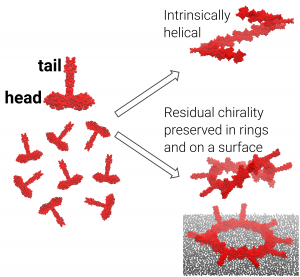How can a surface guide centriole assembly?

Centrioles are cell organelles with a cylindrical shape and a 9-fold radially symmetric architecture. They play a role in the formation of cilia and flagella and originate the mitotic spindle during cell division. Further, as a major component in centrosomes, they are involved in microtubule organization.
At the center of each centriole is the cartwheel, which consists of SAS-6 proteins that self-assemble into stacked ring polymers on the surface of a torus surrounding the mother centriole to initiate growth of a new centriole. So far it was unclear how the intrinsically helical SAS-6 polymers assemble into flat rings and how the symmetry is determined.
Researchers from the MBM-group teamed up with Pierre Gönczys lab in Lausanne. Their investigation on the assembly dynamics of SAS-6 using photothermally-actuated, off-resonance tapping high-speed atomic force microscopy showed that the affinity of SAS-6 head domains is increased by four orders of magnitude on a surface compared to in solution. Coarse-grained molecular dynamics simulations additionally revealed that the presence of a surface favors angles between the SAS-6 monomers compatible with the signature 9-fold symmetry. Remnants of the proteins helical features are reflected in its C-terminal tail domain orientations, which likely aids ring stacking.
Check out the combined results that have recently been published in Nature Communications:
Niccolò Banterle, Adrian P. Nievergelt, Svenja de Buhr, Georgios N. Hatzopoulos, Charlène Brillard, Santiago Andany, Tania Hübscher, Frieda A. Sorgenfrei, Ulrich S. Schwarz, Frauke Gräter, Georg E. Fantner & Pierre Gönczy. Kinetic and structural roles for the surface in guiding SAS-6 self-assembly to direct centriole architecture. Nature Communications 12, (2021)
About HITS
HITS, the Heidelberg Institute for Theoretical Studies, was established in 2010 by physicist and SAP co-founder Klaus Tschira (1940-2015) and the Klaus Tschira Foundation as a private, non-profit research institute. HITS conducts basic research in the natural, mathematical, and computer sciences. Major research directions include complex simulations across scales, making sense of data, and enabling science via computational research. Application areas range from molecular biology to astrophysics. An essential characteristic of the Institute is interdisciplinarity, implemented in numerous cross-group and cross-disciplinary projects. The base funding of HITS is provided by the Klaus Tschira Foundation.